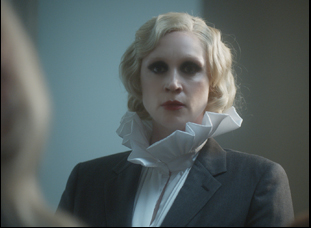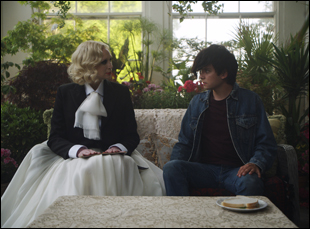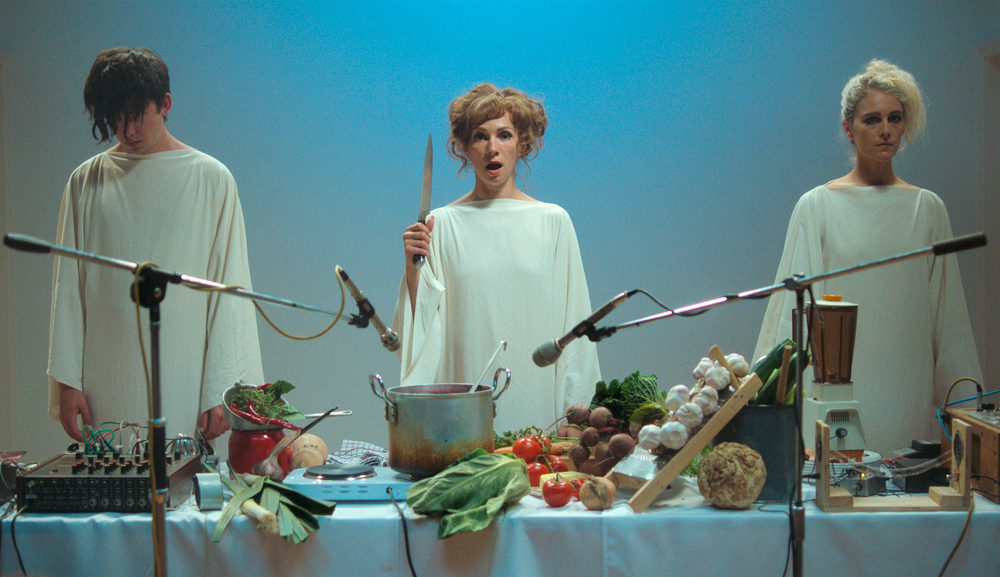“Why did I agree to a public gastronomy?” asks the journalist known as Stones (Makis Papadimitriou) in “Flux Gourmet,” being far more open about himself at the Sonic Catering Institute than anyone he’s supposed to be covering is. Not that he exactly volunteered for this enthusiastically, but the sounds of the stomach are something of a currency at the unusual academy run by the impervious Jan Stevens (Gwendoline Christie) where creativity is encouraged and art truly is left up to personal taste. This is an unfortunate assignment for Stones, who has to suppress a debilitating gastrointestinal disorder while he is there to cover the musicians in residence, a trio led by Elle di Elle (Fatma Mohamed) that uses blenders and sizzling pans for instrumentation, with her bandmates (Asa Butterfield and Ariane Labed) cooking up rhythms as well as carrots.
If this retreat seems well off the reservation, it is very much in the wheelhouse of Peter Strickland, the singular filmmaker behind “Berberian Sound Studio,” “The Duke of Burgundy” and “In Fabric,” who finds the creative process to be torture enough for his characters — there are never any villains in his films — except maybe for gluten, in “Flux Gourmet,” — and sets about a cinema of longing, where desire often is after something more elusive than the feeling of love – complete control. As Stones wrestles with his acid reflux, Elle tussles with Jan over the direction of the group when she believes the act is fully formed while the director believes they’re at the academy to continue to refine themselves and as performance art pieces are road tested, the messy business of artistic expression is allowed to be seen in all its dimensions.
As Strickland explains, “Flux Gourmet” itself was hardly easy to pull off, filmed just after it was considered safe to return to set during the pandemic and yet any struggle appears to have happened behind the scenes when the writer/director is so assured in creating such a fully realized alternate reality to hold a mirror up to the one in which we all reside. With the film now hitting theaters following its premiere earlier this year at Berlinale, he spoke about how he found inspiration in the the act he formed with Colin Fletcher, Én, Tim Kirby, and Zsolt Sőrés nearly 30 years ago and turned it into the basis for his latest film as well as creating its inventive soundscape.

They’re all dealing with food and elementary things, so they connected quite well organically. The whole band thing was a device to incorporate someone with stomach issues into their performances, but that’s also a very cynical thing to do for that band, but it gave me a chance to kind of look at stomach disorders, hopefully with a degree of compassion. But even though I used to be in a band that did this kind of stuff, it was never like, “Oh, let’s just make a film about this kind of thing.” It just kind of happened. I usually don’t know what I’m doing from film to film, and quite often, I’m thinking when I finish a film, “Never again.” So it’s not as if I’m searching for ideas, but it just somehow interrupts me, which I suppose is a blessing in some ways, but sometimes it is a curse as well because making films doesn’t get easier.
What was it like finding the right location for this?
A lot of it was because of the budget, and I wrote it before the pandemic, but had I known a pandemic would be on its way, I would’ve not had those performance scenes because having crowds was a nightmare. But Serena Armitage, one of the producers is from York and she knew a lot of people and she would suggest all these different places and we would go. I think we had like three or four trips to York, and we found this place and it worked. It had this decadence to it that I needed.
Usually, your films are pretty self-contained. Did that make it any easier for a shoot in COVID times?
This was a weird one because there was a huge bottleneck, filming post-lockdown, so I hope no one minds my saying this, but some people I’ve worked with before, you just couldn’t work with them and [I had] all mostly new heads of department, but they were great and it was not an easy shoot. It was a 14-day shoot, and everyone really went for it, so I’m very, very grateful to all of them and they did it very gracefully as well because the money was not great and I think they could have earned so much more money on other films. That’s a huge issue now. You just can’t get crew because the big streaming companies just pay so much more and you just can’t compete with those wages, so it’s tough making independent films now. I don’t know how it’s going to pan out because obviously there’s huge bottleneck of filming going on now and let’s see what happens when things kind of even up a bit more.

Gwendoline, from quite early on, and Fatma as well because I always work with Fatma. But I had to look for people. Makis, I’d seen before in “Chevalier,” but when I saw him in “Suntan” I thought, “Okay, I really need to ask this guy,” and Asa [Butterfield] was very much [the suggestion of] Shaheen Baig, the casting director. I knew his work and I really love what he does, but Shaheen jogged my memory.
When so many of the characters talk about Elle’s backstory, building her up as this larger and larger presence, it got me wondering how much do you actually want to impart to the actors about their characters versus letting them bring their own ideas to the part?
As you say, the backstory is there in the script and usually it’s not. You kind of feed it to an actor and make stuff up for them, but so much is there that they’re saying themselves, so that was quite different. And I think all actors are very different. Some just have zero interest in backstory. They just turn up, they do their stuff, and I don’t mean that with any malice. They’re just all very different and have very different needs, so part of our job as directors is just to adapt ourselves to what the actor needs to get the best performance.
For those performance art pieces in the film, were you actually mixing the sound live on set?
No. We had sound on set just to get the actors in that zone, but that was done in post-production in different stages. It was a mixture of sampling stuff and making stuff with any consistency of what you see [from] using the same equipment – the Watkins Copicat, the tape delay unit. That was quite important to have the same sonic identity as the visual identity.
There were a variety of different musicians credited – what was it like to put together this soundscape?
That was quite different from what I’ve done before because usually I just had one set of people doing the whole soundtrack, so this was more a medley, a mixture of existing music like the Gene Pitney track and people I just knew [such as] Heather Trost and Jeremy Barnes from A Hawk and a Hacksaw who would be right for the thinking walks, and I knew Roj [Stevens] because he was in Broadcast, would be right for the trips to the shops and so on. I knew Sonic Catering Band would be right for the performance pieces and it is a whole mixture. It’s not just musicians. Tim Harrison, the sound designer, did a lot of work, so it’s a whole mix of people.

Many, many, many epiphanies on a daily basis, and we go in quite cold when we do the mix. That’s the best way to do it, just to be open to anything. Just simple things like having a bit of dropout sometimes and introducing a human voice for when the button is pressed. We did a lot of stuff with the human voice, but it’s hidden in the mix. You half hear it and [think], did you hear it? Did you not hear it? There’s this scene with scatological thing with the whole chocolate mousse. We tried lots of things that just wasn’t working and at the very last minute, we got an actor Britta Gardner to do a spoken word piece over that that was not in the script. That was something we did at very, very last minute.
What was it like to premiere this one at Berlin?
It was not like “In Fabric” because we showed “In Fabric” in Toronto where it was a full house for a midnight screening. Everyone was kind of slightly drunk, so it was like a party from the beginning, whereas “Flux,” it was the midst of the pandemic with a restricted audience, so it was very different atmosphere. It was more like a pleasant Sunday afternoon tea party, but yeah. It was hard to gauge. It’s not going to be everyone’s cup of tea. That is for sure, but nothing is, is it?
“Flux Gourmet” opens on June 24th in New York at the IFC Center and Los Angeles at the Laemmle Glendale.




